Get the look: Courtyard Garden Part Two
We continue the deep dive into my Courtyard Garden, exploring herbaceous perennials, spring bulbs, pots and planters, accessories and focal points.
Welcome back to Part Two as we continue dive deeper into the Courtyard Garden planting and how I tie it all together. Thinking of garden planting as ‘stories’ or layers is a really effective and simple method for planting design. It puts your imagination into 3D mode, focusing your attention on height as well as breadth and depth.
Traditionally, borders and container garden arrangements place the shortest ground cover plants at the very front and the tallest at the back. Makes sense. However, it is a little contrived and if you look for inspiration in nature, you’ll see verges and hedgerows peppered with opportunistic ‘taller’ species popping up amongst the low-growing plants.
This is something I really enjoy emulating here in my gardens and the Courtyard is no different. So we do have Erigeron, lavender, and scabious at the front, but also grasses, shrubs, trees intermingled. In fact, I always begin by placing out the tallest trees and shrubs, then creating mini-gardens around them. I encourage you to be brave and mix up your planting. Forget regimented rows. Avoid linear planting. Now, let’s get on with the planting!
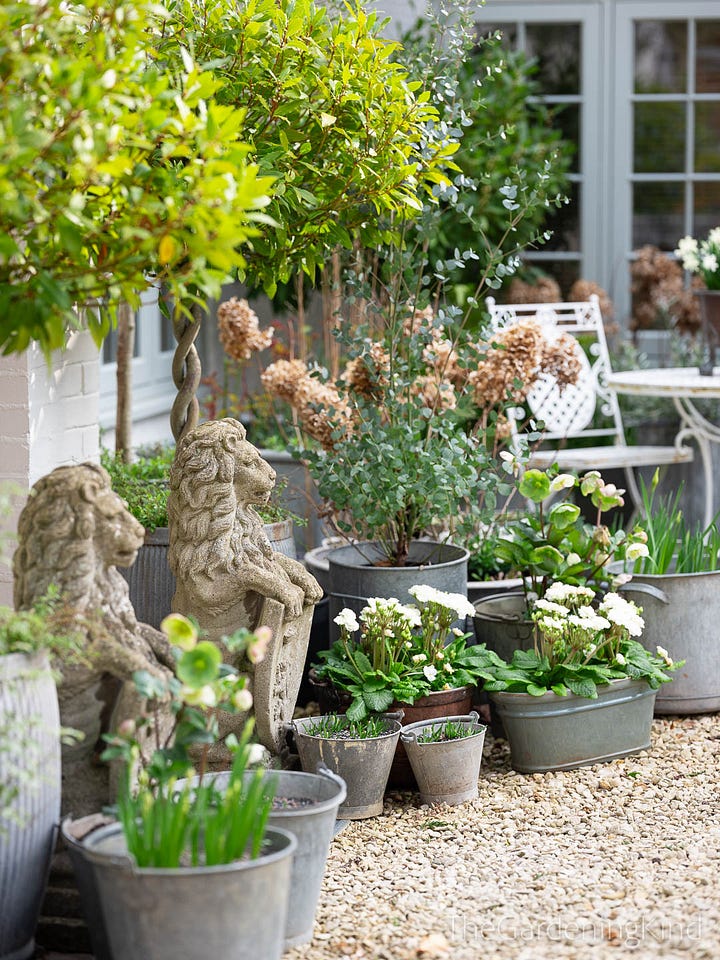

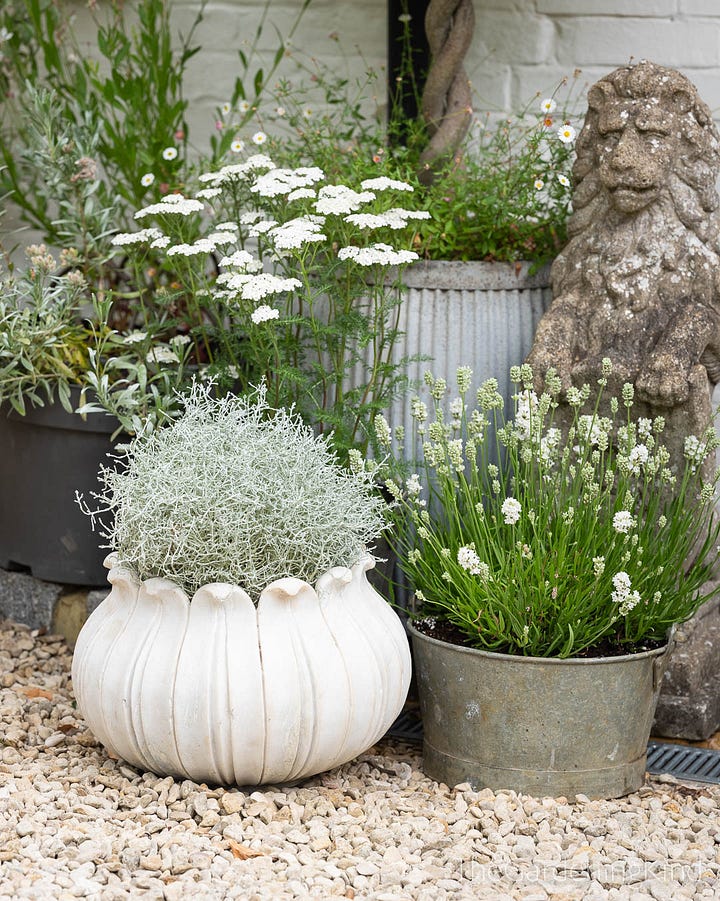
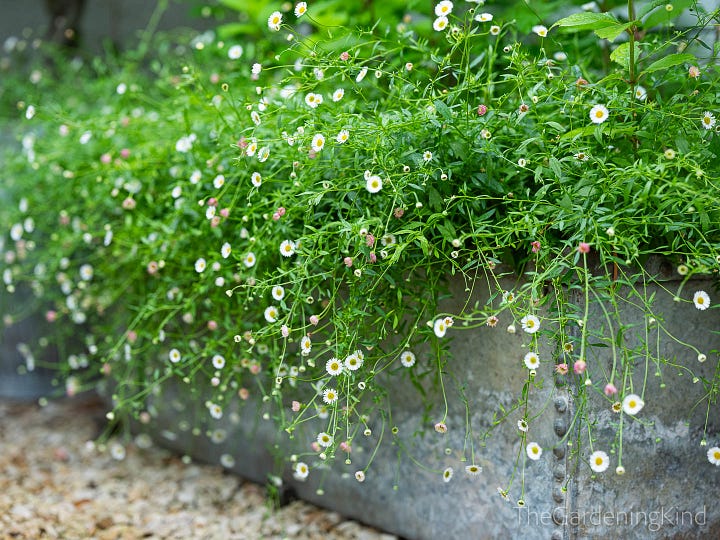
Upper Ground Floor: Herbaceous perennials
The next story down is the eye-catching herbaceous perennials, probably the showiest, attention-grabbing element to the display, save perhaps the roses. They’re not all pure white. Many have a blush of pink or yellow and that is fine. When you stand back, observing the garden as a whole, these delicate tones deepen the range of whites and greens. Most of the selected perennials are frost hardy too and will happily overwinter right where they are. As a reminder, we’re in a USDA maritime Zone 8b equivalent and winter temperatures rarely dip below -5℃ (23℉)
Agapanthus africanus ‘Albus'.
Arguably the most flamboyant and glamorous plant here! Beautiful! Enjoyed by bees. Expensive though and no way near as easy to find as the regular blue cultivars. It's very much a personal taste, but I prefer the pure white, as opposed to 'Twister' or 'Fireworks'. You can buy Agapanthus as bare roots plants, but you may have to wait two seasons or more for a decent bloom.
It’s a good idea to feed these regularly throughout the growing season so they’re fully fuelled for next year's blooms. Deadhead by removing the flower stem right down at the crown. I’m cautious about saying these are fully frost hardy. The RHS rates them as H3 - hardy in coastal and relatively mild parts of the UK down to -5℃ or 23℉. So these will spend the winter in the cold frame or potting shed, just in case.
Gaura lindheimeri 'Summer Breeze’ (syn. Oenothera )
Grown from seed and very easy it was too. The lower leaves tend to go read under stress, which is a great indicator for watering needs. I love how graceful and airy they are, with their blooms dancing high above the foliage. Another one for full sun, but this does like moisture at the roots, but not overly nutritious. Too much goodness and they flop on lush stems. Again, like Agapanthus, it may need winter protection but they're tougher so will probably just be nudged against the house wall, under the eves, out of the winter rains.
Scabiosa ‘Flutter White’
A great value plant, flowering its socks off from June right through to November, if you keep deadheading it. And that’s easy. Just snip faded blooms down to the next set of leaves. Not fussy on soil, but keep it well drained. They’re fully hardy and will tolerate a little shade, but flower best in full sun. Definitely not a hungry plant, but as they’re in pots, they do get a little feed throughout the summer.
Lavandula angustifolia ‘Alba’
The pure white form of English lavender. It has wonderful fragrance from both flowers and foliage, which is why it's positioned either side of the front door, so you get a wonderfully uplifting whiff when you brush past. Like all Lavender, it needs full sun and sharp drainage. I make a particularly gritty compost for these.
When flowering fades in late summer, they’re tidied up with a good trim to keep them bushy. If you leave English lavender to its own devices, it will grow woody and straggly. Actually, they’re all destined to grow woody eventually, but tight pruning will help delay it. A balanced fertiliser for containerised plants is ok, but use it sparingly! A dusting at most. Do not use high nitrogen feeds.
Erigeron karvinskianus
Used as underplanting for all the olives, bays, and roses. I just love it. It’s so relaxed and somehow gives the impression of age and heritage. It flowers practically all year round, in this Courtyard. Each spring it has a haircut to keep it compact. Then, in August, it's given another tidy, just to spur on a fresh flush of foliage and flowers. Not fussy on soil. Will grow in sun, part sun and tolerates shade too, but flowers best in sun.
Gypsophila paniculata ‘Summer Sparkle’
Creates the most beautiful tactile cushions of tiny starry white flowers. I’m not keen on the musky fragrance, but the aesthetics more than make up for it. In the ground, it’ll form a frothy mound up to 1m (3ft) wide. There are three young plants in each planter here and they will be split and potted individually next season. Fully hardy down to -20℃ (-4℉).
Artemisia ‘Coca Cola’
Soft, highly fragrant foliage which, as the name suggests, smells like cola. Actually, I think it smells like fizzy cola bottles! Those of a certain age will remember them from the weekly pocket-money splurge down the local Woolworths’ pic ’n’ mix section. Ah, such a wave of nostalgia.
Calocephalus ‘Silver Macho’
Planted in the white marble lotus bowls this looks remarkably otherworldly. Like coral. It’s just bizarre. For some elusive reason they just work in these planters. They’re half hardy, so worth bringing them under cover during winter and keep them dry!
Achillea millefolium 'White Beauty'
A spreading perennial umbellifer, adored by pollinators of all kind. This yarrow is a hardy sun-lover, gradually filling the planter with fine feathery leaves and flat white flowerheads.
Panicum virgatum 'Heavy Metal’
The only grass, just brings yet another varying shade of metallic blue/grey and a stark change in form. A deciduous grass, this reaches over 1m (3ft) in height and retains its form through the winter in an attractive bronze tone. Fully hardy and drought resistant, it seems perfectly happy in a pot. In spring, when you see new growth emerging, simply chop down all the overwintered stems.
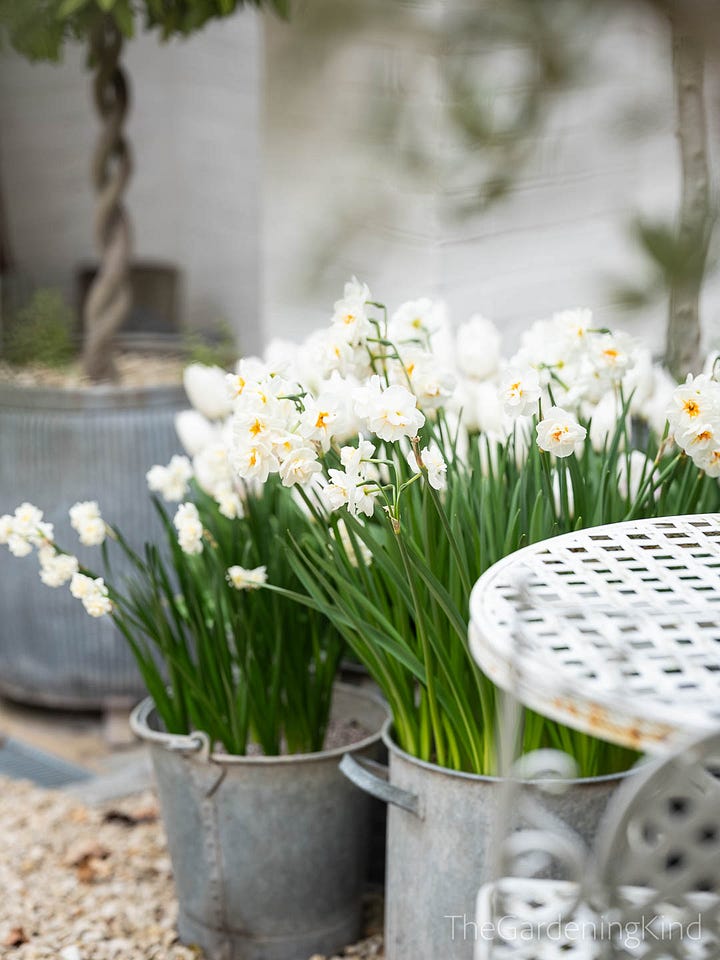
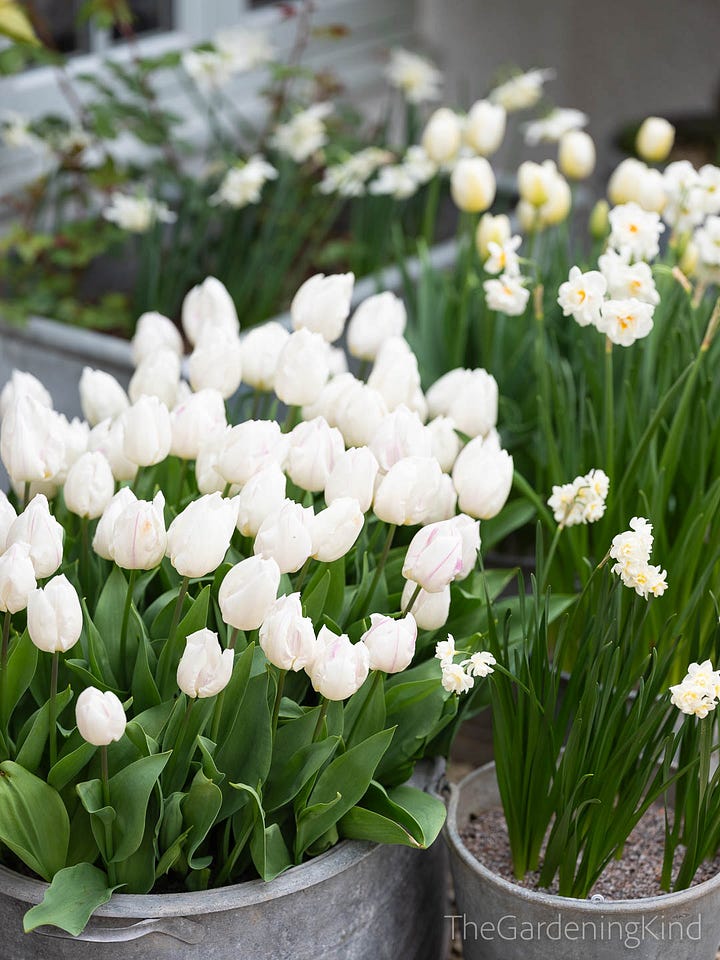
Lower ground floor: Spring bulbs
On the ground story, the final layer, winter and spring flowering bulbs will give you the first white blooms of the season. White flowering Cyclamen coum, autumn and winter snowdrops (Galanthus) will kick start the flowering season and also provide much-needed nectar for emerging bumblebees and solitary bees.
The pure white Narcissus ‘Thalia’ and N. ‘Triandrus Tresamble’ bloom amongst the roses. Galvanised buckets filled with N. 'Winston Churchill', and N. 'Bridal Crown', both white with a central blush of orange/yellow and both with an outstanding, beautifully rich perfume.
Tulips arrive in April and flow through to May. We regularly grow 'White Triumphator', 'Purissima', 'White Prince', and 'Spring Green’. Lastly, the architectural alliums with the towering 'Mount Everest' and 'White Giant', although you need to park these behind other pots to hide their leaves which die off as they flower.
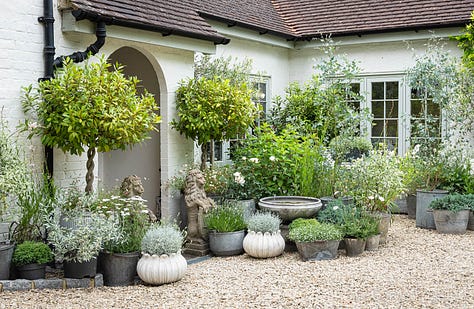
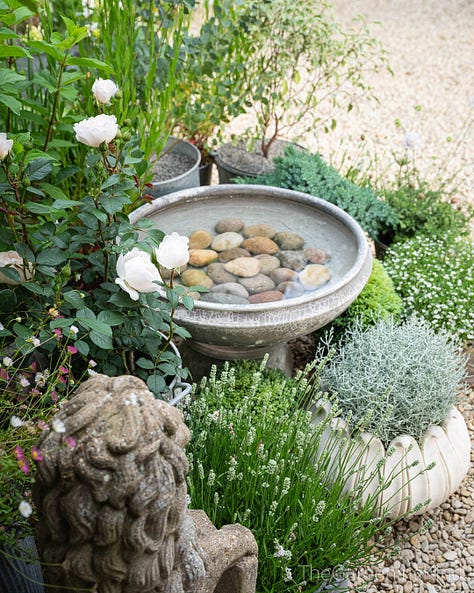
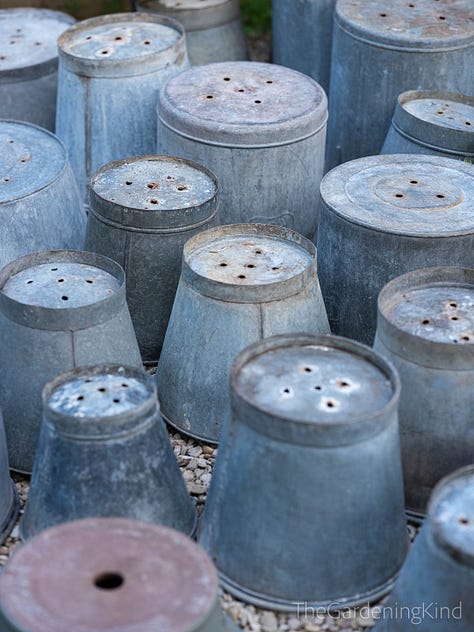
Bringing it all together
Now, with all plants accounted for, you can see that we’ve created multiple stories from tree-tip to bulb root, with layers of planting, all bringing varying shades of green and white, all with noticeably different forms. Together they produce this maximalist effect, with interest and depth, with a long season of interest and potentially year-round flowering.
There are two features that tie all the planting together. One is the simple and elegant colour scheme… all the greens. It’s a very restful and calming palette. The other is the containers! They’re nearly all (90%) vintage galvanised pots and planters and they’re all varying sizes, shapes, and heights: Baths, boilers, buckets, troughs, tanks, and dolly tubs. Despite the variations, the matt-grey, oxidised-zinc tone blends them together.
High-end companies like A Place In The Garden, Agriframes, and Arthur Jack have genuine hot-dipped zinc galvanised planters, lavishly priced, but they will last for decades, if not longer. For those on a more modest budget, I strongly recommend buying vintage. Most vintage galvanised buckets are £15-£30, small oval baths up to £60, and dollies over £100. But these will all last!
Modern garden centre fabrications are more expensive than vintage items, but paper-thin! Their only guarantee is that they will rust, if not disintegrate entirely, staining your paving or patio slabs in the process.
Whatever, you decide to use (whether it’s galvanised vintage planters, ceramics, terracotta, etc.) make sure they are varying heights, styles and sizes. If all the planting is in the exact same pots, the display can look rather forced, regimented, and somewhat sterile. To me, the Courtyard Garden works so well because of the diversity of both the planting but especially the planters, yet all keeping to that harmonious palette.
More than plants
Accessorising
I firmly believe a garden is more than just a collection of plants and more than the sum of its constituent parts. The Courtyard is no different. We've talked through the harmony of plants and planters, but amongst the acres of galvanised, we place markedly different, feature planters: A copper boiler on feet; A vintage French cast iron jardiniere; Two hand-carved white Makrana marble Lotus Bowls. Typically, there are no more than three feature planters in the whole display, just enough to catch the eye and raise an eyebrow.
Nestled in amongst the planting, you'll find a low-key water feature. The Lotus Bowl from True Fair Trading that just adds another sensory layer. A serenely calming sound of softly babbling water mixing with the breeze through the leaves, and the buzzing of insects.
Either side of the front door, there are two stone lion guardians, just for a little playful theatre. They're also the right height to give them a little pat when you leave the house… just for good luck.
Focal point
Accessories can be subtle, but the focal point needs to grab your attention, either with colour, scale, or something that draws you in, like an inviting place to sit. The final element in the Courtyard is the white bistro table set. And it's not just for looking. I sit here and have a well-earned brew when I’m working round the front of the house. It's a delightful place to take five, surrounded by blooms, fragrance, and busy buzzing pollinators.
It doesn’t have to be garden furniture: Water features, garden art, classical sculpture, bird tables, dovecot, a giant urn on a plinth... Anything that anchors the space and draws the eye inward. And be brave!
Final thoughts…
Don’t limit yourself by ramming all the planting against the wall. Be playful and combine pots and plants together, mixing up the heights and sizes. You’re making a garden, not organising a chess board! Spread the planting outwards, if you have the room and make sure pots are clustered together.
If there is seating, surround it with fragrant planting, so when you do sit there, it’s a true multi-sensory experience. I’ve positioned lavender either side of the front door to get that uplifting waft. Artemisia ‘Coca Cola’ by the chairs so you brush against them for a nostalgic hit when you sit down. Roses all around the seating, planted in taller troughs so those heavily-scented blooms are nose-height.
Above all, enjoy it. Have fun. Make it your own. It is your garden after all!
Plant List:
Shrubs & Trees:
Bay, Laurus nobilis
Olive, Olea europaea
Rosa ‘Desdemona’
Rosa ‘Winchester Cathedral’
Hydrangea paniculata ‘Living Sugar Rush’
Eucalyptus gunnii ‘Silverana’
Juniperus squamata 'Blue Star'
Convolvulus cneorum
Pittosporum tenuifolium 'Silver Queen'
Herbaceous & Bulbs:
Erigeron karvinskianus
Scabiosa 'Flutter White'
Agapanthus africanus ‘Albus'
Lavandula angustifolia ‘Alba’
Gypsophila ‘Summer Sparkle’
Gaura lindheimeri 'Summer Breeze’
Achillea millefolium 'White Beauty'
Artemisia ‘Coca Cola’
Calocephalus ‘Silver Macho’
Narcissus: ‘Thalia’, ‘Triandrus Tresamble’, 'Winston Churchill', 'Bridal Crown'
Tulip: 'White Triumphator', 'Purissima', 'White Prince', 'Spring Green’
Cyclamen coum
Coming up…
Keeping with the theme of garden design, we take a look at some of my biggest mistakes and they’re mostly centred around my Cottage Garden, the area I struggle with most of all!


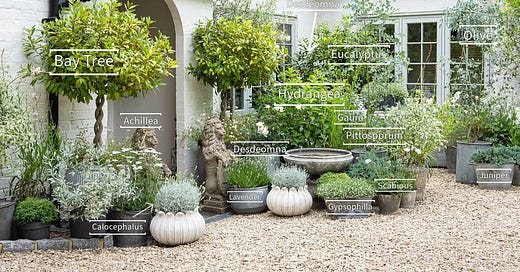




This is such a great list of plants! And I am truly envious of the containers here. Really really beautiful design. Thank you for sharing your process!
Wow, super useful image with what plant is what! I adore how that looks